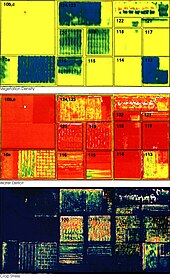


Precision agriculture (PA) is a farming management strategy based on observing, measuring and responding to temporal and spatial variability to improve agricultural production sustainability.[2] It is used in both crop and livestock production.[3] Precision agriculture often employs technologies to automate agricultural operations, improving their diagnosis, decision-making or performing.[4][5] The goal of precision agriculture research is to define a decision support system for whole farm management with the goal of optimizing returns on inputs while preserving resources.[6][7]
Among these many approaches is a phytogeomorphological approach which ties multi-year crop growth stability/characteristics to topological terrain attributes. The interest in the phytogeomorphological approach stems from the fact that the geomorphology component typically dictates the hydrology of the farm field.[8][9]
The practice of precision agriculture has been enabled by the advent of GPS and GNSS. The farmer's and/or researcher's ability to locate their precise position in a field allows for the creation of maps of the spatial variability of as many variables as can be measured (e.g. crop yield, terrain features/topography, organic matter content, moisture levels, nitrogen levels, pH, EC, Mg, K, and others).[10] Similar data is collected by sensor arrays mounted on GPS-equipped combine harvesters. These arrays consist of real-time sensors that measure everything from chlorophyll levels to plant water status, along with multispectral imagery.[11] This data is used in conjunction with satellite imagery by variable rate technology (VRT) including seeders, sprayers, etc. to optimally distribute resources. However, recent technological advances have enabled the use of real-time sensors directly in soil, which can wirelessly transmit data without the need of human presence.[12][13][14]
Precision agriculture has also been enabled by unmanned aerial vehicles that are relatively inexpensive and can be operated by novice pilots. These agricultural drones[15] can be equipped with multispectral or RGB cameras to capture many images of a field that can be stitched together using photogrammetric methods to create orthophotos. These multispectral images contain multiple values per pixel in addition to the traditional red, green blue values such as near infrared and red-edge spectrum values used to process and analyze vegetative indexes such as NDVI maps.[16] These drones are capable of capturing imagery and providing additional geographical references such as elevation, which allows software to perform map algebra functions to build precise topography maps. These topographic maps can be used to correlate crop health with topography, the results of which can be used to optimize crop inputs such as water, fertilizer or chemicals such as herbicides and growth regulators through variable rate applications.
- ^ "Precision Farming : Image of the Day". earthobservatory.nasa.gov. 30 January 2001. Retrieved 12 October 2009.
- ^ "Precision Ag Definition | International Society of Precision Agriculture". www.ispag.org. Retrieved 20 December 2021.
- ^ Monteiro, António; Santos, Sérgio; Gonçalves, Pedro (2021). "Precision Agriculture for Crop and Livestock Farming—Brief Review". Animals. 11 (8): 2345. doi:10.3390/ani11082345. hdl:10400.19/6997. PMC 8388655. PMID 34438802.
- ^ The State of Food and Agriculture 2022 − Leveraging agricultural automation for transforming agrifood systems. Rome: Food and Agriculture Organization of the United Nations (FAO). 2022. doi:10.4060/cb9479en. ISBN 978-92-5-136043-9.
- ^ In Brief to The State of Food and Agriculture 2022 − Leveraging automation in agriculture for transforming agrifood systems. Rome: Food and Agriculture Organization of the United Nations (FAO). 2022. doi:10.4060/cc2459en. ISBN 978-92-5-137005-6.
- ^ McBratney, A., Whelan, B., Ancev, T., 2005. Future Directions of Precision Agriculture. Precision Agriculture, 6, 7-23.
- ^ Whelan, B.M., McBratney, A.B., 2003. Definition and Interpretation of potential management zones in Australia, In: Proceedings of the 11th Australian Agronomy Conference, Geelong, Victoria, 2–6 Feb. 2003.
- ^ Howard, J.A., Mitchell, C.W., 1985. Phytogeomorphology. Wiley.
- ^ Kaspar, Thomas C.; Colvin, Thomas S.; Jaynes, Daniel B.; et al. (March 2003). "Relationship Between Six Years of Corn Yields and Terrain Attributes". Precision Agriculture. 4 (1): 87–101. Bibcode:2003PrAgr...4...87K. doi:10.1023/A:1021867123125. ISSN 1385-2256. S2CID 40514787.
- ^ McBratney, A. B.; Pringle, M. J. (September 1999). "Estimating Average and Proportional Variograms of Soil Properties and Their Potential Use in Precision Agriculture". Precision Agriculture. 1 (2): 125–152. Bibcode:1999PrAgr...1..125M. doi:10.1023/A:1009995404447. ISSN 1385-2256. S2CID 22339888.
- ^ Reyns, P., Missotten, B., Ramon, H. et al. Precision Agriculture (2002) 3: 169. https://doi.org/10.1023/A:1013823603735
- ^ M. Sophocleous et al., "A Stand-Alone, In Situ, Soil Quality Sensing System for Precision Agriculture," in IEEE Transactions on AgriFood Electronics, doi: 10.1109/TAFE.2024.3351953.
- ^ M. Sophocleous and J. Georgiou, “Precision agriculture: Challenges in sensors and electronics for real-time soil and plant monitoring,” 2017 IEEE Biomed. Circuits Syst. Conf., pp. 1–4, 2017. https://doi.org/10.1109/BIOCAS.2017.8325180
- ^ Sophocleous, M. (2016). "IoT & Thick-Film Technology for Underground Sensors in Agriculture".
- ^ "DJI Agriculture".
- ^ Anderson, Chris (May–June 2014). "Agricultural Drones Relatively cheap drones with advanced sensors and imaging capabilities are giving farmers new ways to increase yields and reduce crop damage". MIT Technology Review. Archived from the original on 7 March 2017. Retrieved 21 December 2016.